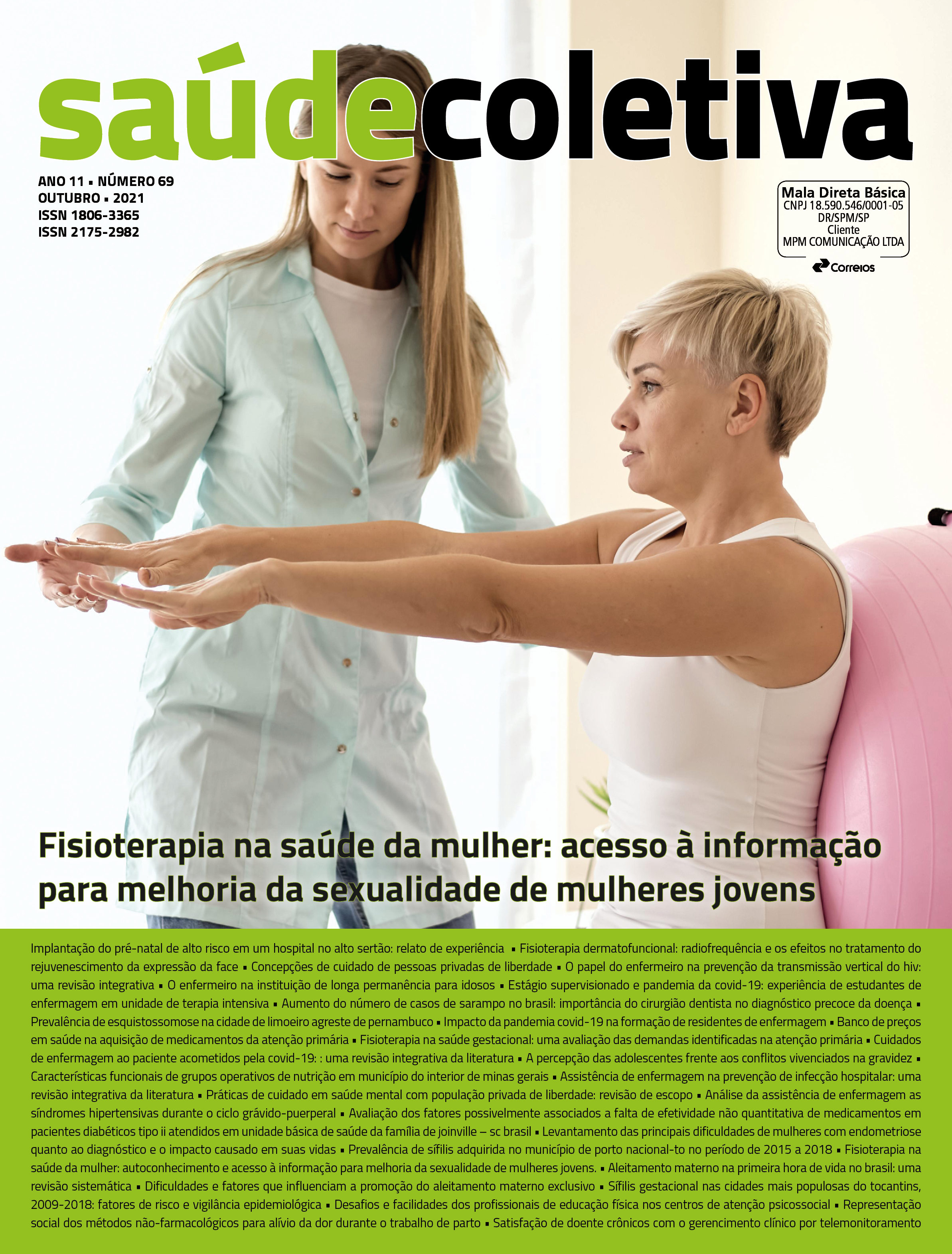Evidence about the occurrence of complications related to unbalanced volume of the chronic kidney patient
DOI:
https://doi.org/10.36489/saudecoletiva.2021v11i69p8608-8617Keywords:
Renal Dialysis, Water-Electrolyte lmbalance, Renal lnsufficiency ChronicAbstract
Objective: Search the literature for evidence on the occurrence of complications related to unbalanced blood volume in chronic renal patients. Method: This is an integrative review with the purpose of identifying evidence in the literature to support the construction of the scale for measuring the risk of hypervolemia in chronic kidney patients undergoing hemodialysis treatment. The search was carried out between August and October 2020, in the following databases: LILACS, SCIENCE DIRECT, COCHRANE LIBRARY and in the PUBMED and EBSCO portais, with operators crossing. The initial search found 129 articles, 02 Cochrane Library, 59 Lilacs, 12 Pubmed, 55 Ebsco and 01 Science Direct. Results: After conducting a search for scientific evidence, it is necessary to briefly present the results found. ln the characterization of the articles, it was observed that 88% of the studies are international, and the object of study turned to the investigation of the relationship of hypervolemia and its influence on the cardiac and pulmonary function of chronic kidney patients. Conclusion: Therefore, most of the problems are due to excess flui d, with a view to alerting health professionals, especially nurses, enabling them to reason about which interventions would be effective.
References
Lima M A, Sousa G R, Sousa A M et ai. Educação em saúde para pacientes em hemodiálise. Rev enferm UFPE on line; 2014; 8(6):1510-5. 2. Sociedade Brasileira De Nefrologia. O que é hemodiálise?. São Paulo: SBN [Internet]. 2017 [cited 2020 Apr 30]; Available from: http:#sbn.org.br/publico/tratatamentos/hemodialise/ 3. Fernandes M I C D, Medeiros A B A, Macedo B M, Vitorino A B, Fernandes L M V O, Lira A L B C. Prevalence of nursing diagnosis of fluid volume excess in patients undergoing hemodialysis. Revista da Escola de Enfermagem da LISP [Internet]. 2014 [cited 2021 May 20];48:446-453. □OI https:#doi.org/10.1590/50080- 623420140000300009 .Avai lab I efrom: https:#www.sci elo. br /j/ reeusp/a/VMVzwRPzK36HPgbFbbclqSK/?lang=enttModalArticles. 4. Burcharles E, Gardano S, Varela A M, Barberato S H, Pecoits - Filho R. Avaliação e manejo da doença cardiovascular em pacientes com doença renal crônica. J Bras Nefrol. 2010;32:120-127. 5. Quaglio W H, Bueno W M V, Almeida E C, et ai. Dificuldades enfrentadas pela equipe de enfermagem no cuidado aos pacientes transplantados: revisão integrativa da literatura. Arq. Cienc. Saúde UNI PAR. 2017;21 :53-58 6. Souza M T. Silva M D, Carvalho R. Revisão integrativa: o que é e como fazer. Einstein. 2010;8. 7. Ursi E S. Prevenção de lesões de pele no perioperatório: revisão integra tiva daliteratura. 2005. 1: 128. 8. Melnyk B M, Fineout-Overholt E. Making the case for evidence-based practice. Evidence-based practice in nursing & health care - a guide to best practice. Philadelphia: Lippincot Williams & Wilkins, 2005. 9. Smeltzer S C et ai. Brunner & Suddarth: tratado de enfermagem médicocirúrgica. 12ª ed. Rio de Janeiro: Grupo Editorial Nacional Participações 5/A (GEN). 2011 10. Vibhu D et ai. lsolated pleural effusion as a presentation of high cardiac output heart failure in a hemodialysis patient. Hemodial lnt. 2012; 16:54-57. 11. Selem S S A C et ai. Validade da Hipertensão Autorreferida Associa-se Inversamente com Escolaridade em Brasileiros. Arq. Bras. Cardiol. 2013 May 14;100(1):52-59. 12. Safa J et ai. Effect of Hemodialysis on Pulmonary Function Tests and PlasmaEndothelin Leveis. Saudi J. Kidney Ois. Transpl. 2014 Jun 22;25(4):781-787. 13. Zoccali C et ai. Lung congestion as a risk factor in end-stage renal disease. Blood Purif. 2013;36:184-191. 14. Fernandes M I C D et ai. Alterações cardiovasculares e pulmonares em pacientes submetidos à hemodiálise. Rev enferm UERJ. 2016;24 15. Frazão C M F Q et ai. Problemas adaptativos de pacientes em hemodiálise: aspectos socioeconômicos e clínicos. Rev Latino-Am Enfermagem. 2014;22:966-972 16. Barbosa CP et ai. lntraocular pressure and ocular perfusion during hemodialysis. Arq. Bras. Oftalmol.[online]. 2011; 74(2): 106-109. Disponível em: 17. Cerqueira D P, et ai. Fatores preditivos da insuficiência renal e algoritmo de controle e tratamento. Rev Latino-Am Enfermagem. 2014;22:211-7.







